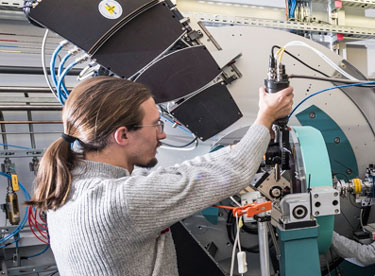ENGINEERING
Powder diffraction has important applications in the world of mechanical engineering, particularly in the mapping of residual strain fields, the detection of phases that degrade the material's properties, mapping the texture of the material, and determining grain size and the degree of cold work.
MATERIALS SCIENCE
The flexibility to accommodate different sample environments and the data quality (in terms of resolution and peak to background ratio) offered by this beamline are essential for the characterization of the new complex materials required for fields as diverse as future communications technology (dielectrics and ferroelectrics, magneto-resistive materials), energy needs (fuel cell and battery electrodes, photo-catalysts), the optimization of industrial processes (like functionalised microporous and mesoporous materials, zeolites and materials for the treatment of radioactive waste), the development of new drugs, etc. The beamline allows engineers to perform "in-situ" experiment during "industrial treatment processes" or "synthesis processing conditions" using time resolved experiments, which leads to the efficient design of materials that have the desired properties.
MINERAL PROCESSING AND SOIL SCIENCES
Powder diffraction is most frequently used in the mineral processing industries during mineral exploration and the orebody evaluation. Laboratory data has served and continues to serve most of the technical and scientific study cases. However, as mineralogy grows in complexity, ore grades become lower and beamline data quality is required to conduct a full characterization. The synchrotron-based powder diffraction technique inherently provides the high resolution, high sensitivity and the rapid-time resolution (typically minutes) that is critical in such studies.
PHARMACEUTICALS
Powder diffraction has a key role to play in structural studies of pharmaceuticals and their interaction with low-molecular weight peptides. Powder diffraction patterns already play a key role in unequivocally establishing the crystalline form of a pharmaceutical in a manufactured drug. The excellent statistics of the Mythen II detector allows the "in situ" study of structural transformation.






